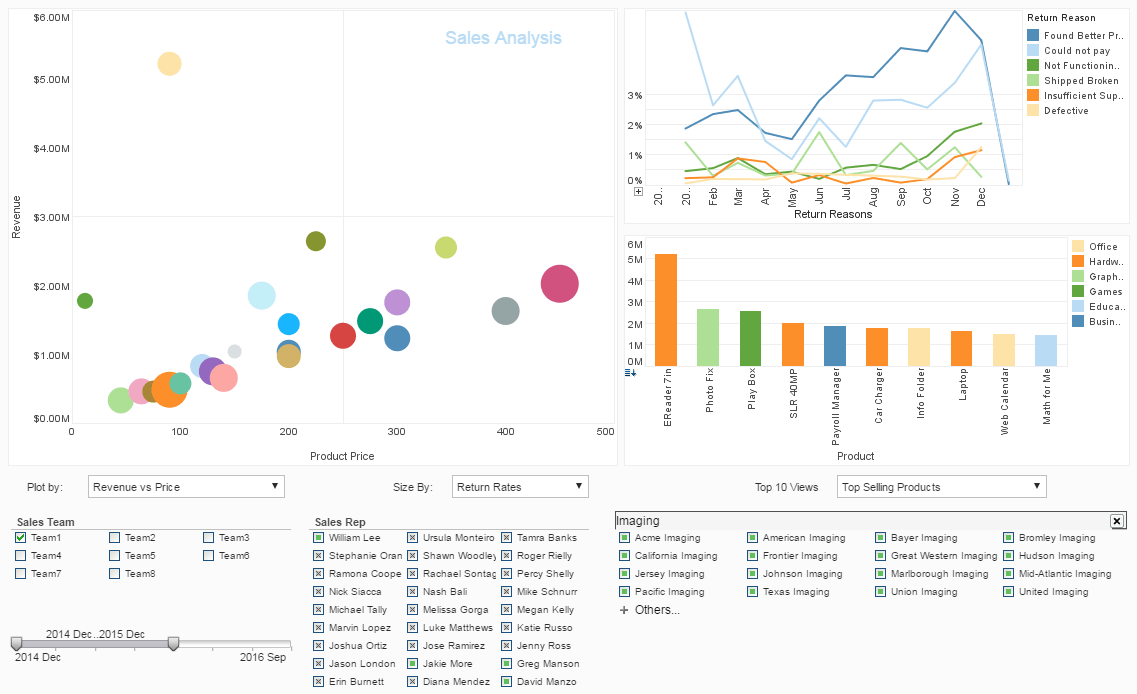Getting Started With Key Performance Indicators
Below is the transcript of a Webinar hosted by InetSoft on the topic of Best Practices for Key Performance Indicators. The presenter is Mark Flaherty, CMO at InetSoft.
Mark Flaherty (MF): During the slow economic climate of the past couple of years and with all the focus on operational information, people are trying to squeeze out the best possible performance. With less people having to do more work, there’s a pressure to find time to try to keep up with the business performance. Add to that the decade’s long shift in business management philosophy towards fact based decision support.
Now more than ever, managers want to be able to say this is what is going on, and this is what we have got to do. The more that you can quantify your business, and run your operation with KPI’s, the better off you will be. Most people are familiar with the financial performance metrics like revenue and profit, but almost every facet of a business can be measured and key performance indicators can be selected.
Selecting the proper metrics is key, naturally. You have to get people from multiple parts of the organization involved. First, you have to understand what data do you have? What data is clean and can be used safely to drive these KPI’s? You don’t want garbage in, garbage out.
| #1 Ranking: Read how InetSoft was rated #1 for user adoption in G2's user survey-based index | Read More |
It really does require some serious meetings between key people across the enterprise to figure what data you have got, what are you really trying to accomplish, and let that drive your determination of metrics.
You can reduce complex business activity to individual metrics, and then you will be able to say what exactly is happening. The data may not contain the answer to a problem on it is own, but once you understand what a KPI is telling you, it’s a powerful tool. It’s particularly useful for backing up decisions, being able to point to quantifiable observations.
What KPIs Does the Manager of Fast Food Operations Track?
The manager of fast food operations oversees various aspects of the restaurant's performance to ensure efficiency, quality, and profitability. They track key performance indicators (KPIs) that provide insights into operational effectiveness, customer satisfaction, and financial performance. Here are some common KPIs that a manager of fast food operations might track:
-
Sales Revenue: Total revenue generated from food and beverage sales, including dine-in, drive-thru, and delivery orders. Monitoring sales revenue helps assess the restaurant's overall performance and identify trends in customer demand.
-
Average Transaction Value (ATV): The average amount spent by customers per transaction. Increasing ATV through upselling, cross-selling, and promotional offers can boost revenue and profitability.
-
Customer Satisfaction Scores: Customer satisfaction scores, measured through surveys, feedback forms, or online reviews, provide insights into the quality of food, service, cleanliness, and overall dining experience. High customer satisfaction scores indicate satisfied customers who are likely to return and recommend the restaurant to others.
-
Speed of Service: The average time it takes to process orders and serve customers, including order-taking, food preparation, and delivery. Monitoring speed of service helps identify bottlenecks in the operational process and improve efficiency to reduce wait times and enhance customer satisfaction.
-
Order Accuracy Rate: The percentage of orders that are prepared and delivered correctly to customers. Ensuring high order accuracy minimizes errors, reduces waste, and enhances customer trust and loyalty.
-
Food and Labor Costs: Food and labor costs as a percentage of total sales revenue. Managing food and labor costs effectively helps maintain profit margins while delivering value to customers.
-
Inventory Turnover Ratio: The number of times inventory is sold and replaced within a specific period. A high inventory turnover ratio indicates efficient inventory management, minimizing waste and obsolescence while ensuring product availability.
-
Employee Turnover Rate: The percentage of employees who leave the organization within a given period. High employee turnover can disrupt operations, increase training costs, and affect service quality. Monitoring employee turnover helps identify retention issues and implement strategies to improve employee satisfaction and engagement.
-
Health and Safety Compliance: Compliance with health and safety regulations, including food safety standards, cleanliness, and employee hygiene practices. Ensuring compliance with health and safety requirements protects customers and employees and preserves the restaurant's reputation.
-
Profitability Metrics: Profitability metrics such as gross profit margin, net profit margin, and return on investment (ROI). Monitoring profitability metrics helps assess the restaurant's financial performance and identify opportunities for cost savings and revenue growth.
What KPIs Does a Tax Accountant Track?
Tax accountants play a vital role in ensuring compliance with tax laws, optimizing tax strategies, and minimizing tax liabilities for individuals and businesses. They track key performance indicators (KPIs) to assess the effectiveness of their tax services and measure their impact on clients' financial outcomes. Here are some common KPIs that a tax accountant might track:
-
Tax Return Accuracy Rate: The percentage of tax returns prepared without errors or discrepancies. Ensuring high accuracy in tax returns minimizes the risk of audits, penalties, and legal issues for clients, while also building trust and credibility for the tax accountant.
-
Tax Savings Achieved: The total amount of tax savings achieved for clients through legitimate tax planning strategies, deductions, credits, and exemptions. Tracking tax savings demonstrates the value added by the tax accountant in reducing clients' tax liabilities and maximizing their financial resources.
-
Client Satisfaction Scores: Client satisfaction scores, measured through surveys, feedback forms, or client reviews, provide insights into the quality of service, responsiveness, and overall client experience. High client satisfaction scores indicate satisfied clients who are likely to retain the tax accountant's services and refer new clients.
-
Timeliness of Filing: The percentage of tax returns filed on time without extensions. Meeting tax filing deadlines ensures compliance with tax laws and avoids penalties and interest charges for late filings.
-
Effective Tax Rate Reduction: The percentage reduction in clients' effective tax rates achieved through tax planning and optimization strategies. Lowering clients' effective tax rates helps maximize after-tax income and improve overall financial performance.
-
Client Retention Rate: The percentage of clients who continue to use the tax accountant's services over time. High client retention rates indicate client loyalty and satisfaction with the tax accountant's services, leading to stable revenue streams and long-term client relationships.
-
Regulatory Compliance: Compliance with tax laws, regulations, and reporting requirements at the federal, state, and local levels. Ensuring regulatory compliance protects clients from audits, penalties, and legal risks, while also maintaining the tax accountant's professional reputation and credibility.
-
Referral Rate: The percentage of new clients acquired through referrals from existing clients or professional networks. A high referral rate indicates client satisfaction and trust in the tax accountant's expertise, leading to organic growth and business expansion.
-
Continuing Education and Professional Development: Participation in continuing education programs, certifications, and professional development activities relevant to tax accounting. Staying updated on tax laws, regulations, and industry trends ensures the tax accountant's competence and ability to provide high-quality service to clients.
-
Revenue and Profitability Metrics: Revenue generated from tax preparation, consulting, and advisory services, as well as profitability metrics such as gross profit margin and net profit margin. Monitoring revenue and profitability metrics helps assess the financial performance of the tax accounting practice and identify opportunities for growth and efficiency improvement.



